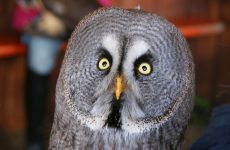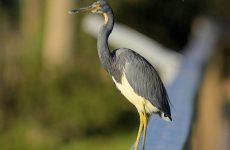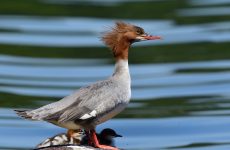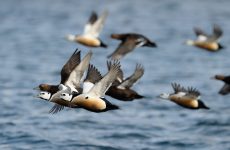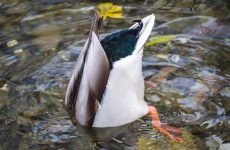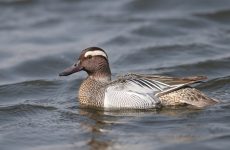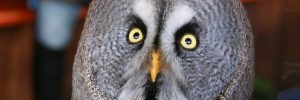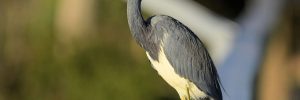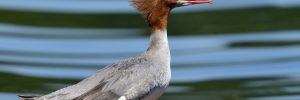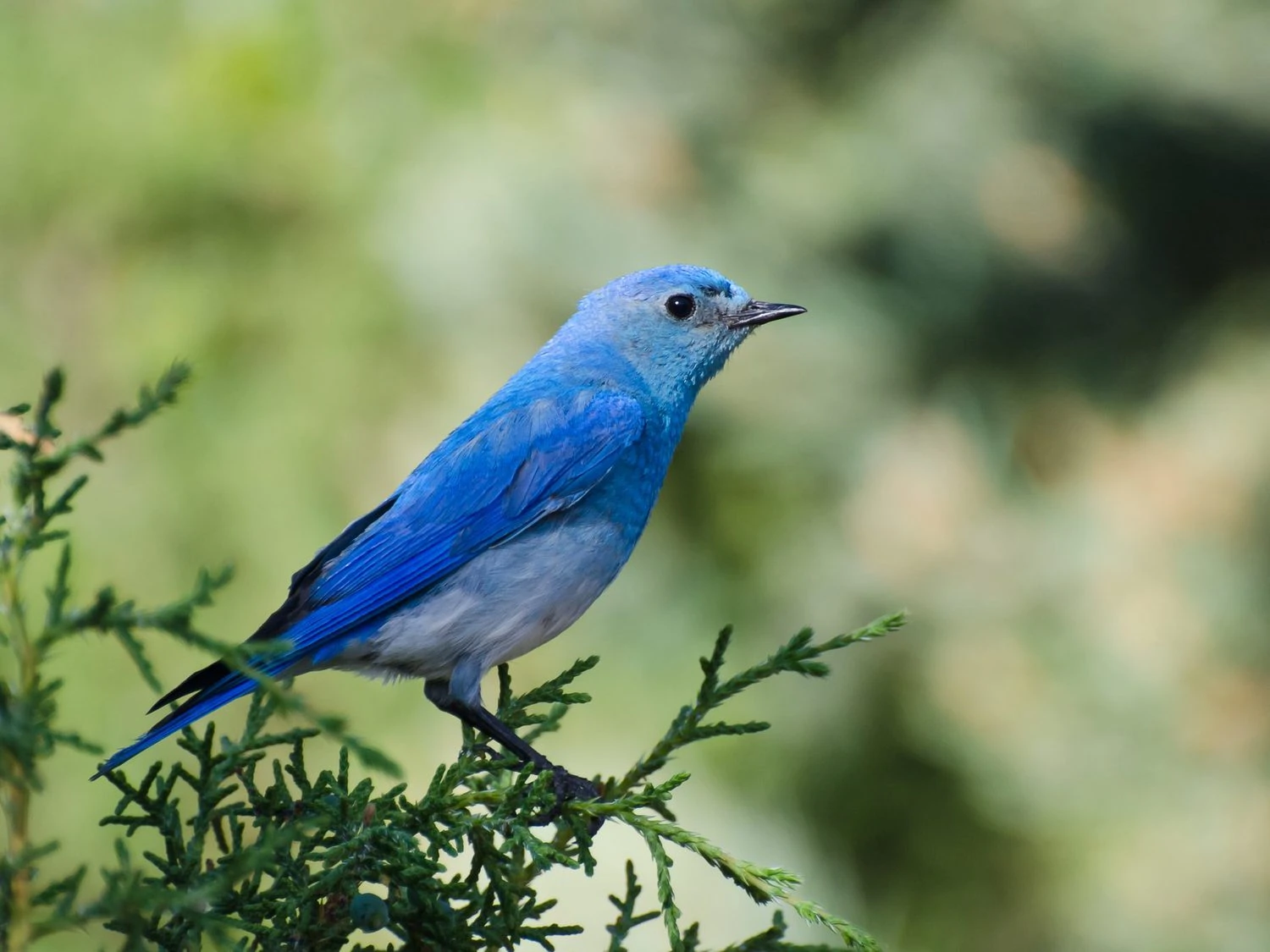
Have you seen a beautifully blue-colored bird and wondered what it is? But did you know this bird is tricking you and it is just an illusion?
There are NO BLUE COLORED BIRDS in the world it is just a neat trick of the light.
If you just want to ID some birds that look blue then I’ve got what you need too. There are lots of birds other than Blue Jays or the rest of the Jay family that are blue. Bluebirds are the most familiar but there are also warblers, grosbeaks and buntings that are blue in North America.
The sky is blue because the air molecules scatter the light and cause it to change wavelength so you ‘see’ the sky as blue and blue feathers work in a similar way. The tiny air pockets in the feathers scatter the light and most of the light passes through except blue light which is reflected instead so you see blue.
If you see a Blue Jay feather from the back it will not look blue and is actually brown. It is a structural color and not a pigment color. So there you go mind blown!
So check them out.
21 Blue Colored Birds:
1. Eastern Bluebird
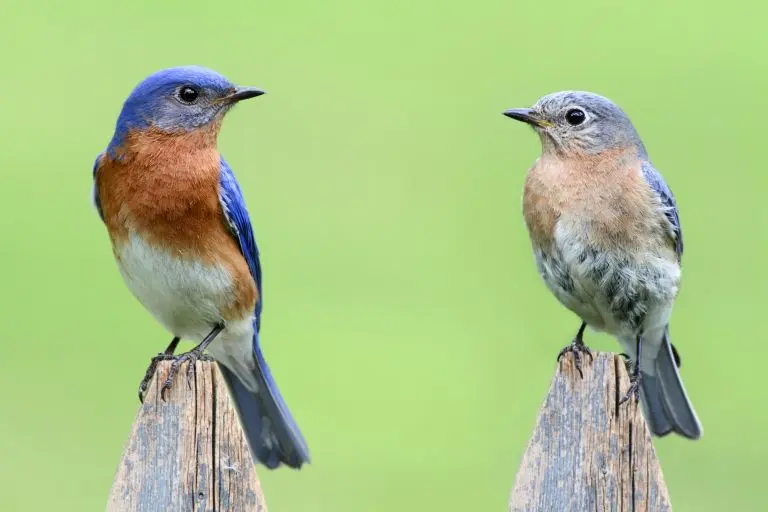
Eastern Bluebirds are small thrushes with big, rounded heads, large eyes, and big bellies.
The males are deep blue on the back and a reddish color underneath. Females are grayer above with some blue in the wings and tail and a less vivid orange-brown breast.
- Sialia sialis
- Length: 6.3-8.3 in (16-21 cm)
- Weight: 1.0-1.1 oz (28-32 g)
- Wingspan: 9.8-12.6 in (25-32 cm)
They live all year in southeastern US states, but those that breed in the northern US and southern Canada migrate south.
You can find Eastern bluebirds in meadows, and they can often be spotted perched on wires and posts or low branches, looking for insects.
Eastern Bluebird Song:
Attract Eastern Bluebirds to your backyard by offering mealworms and nest boxes if your yard is pretty open and spacious.
2. Western Bluebird
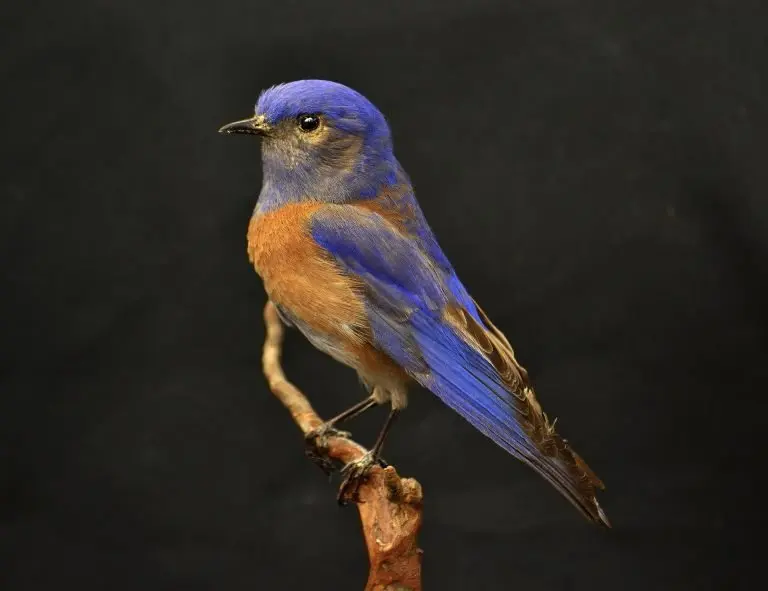
Western Bluebirds are blue birds with orange chests. They are very social small stocky thrushes that are shiny blue on the back and rust-orange on the breast and across the upper back in the males.
Females are not so bright and instead, they are a dull buff-gray, with pale orange on the breast and blue tints to the wings and tail.
- Sialia mexicana
- Length: 6.3-7.5 in (16-19 cm)
- Weight: 0.8-1.1 oz (24-31 g)
- Wingspan: 11.4-13.4 in (29-34 cm)
Western Bluebirds are found in western US states and do not usually migrate. However, some birds in the far northwest may migrate south or to lower elevations.
You can find Western Bluebirds in woodlands rather than open areas, and they are readily found in areas that have dead trees, such as burned forests and logged areas.
I Summer Western Bluebirds cat insects such as caterpillars, beetles, and ants, as well as spiders and snails or other ground-dwelling insects. In winter, Western Bluebirds eat fruit such as elderberry, grapes, mistletoe, raspberries, blackberries, sumac, and juniper.
Western Bluebird songs:
Attract Western Bluebirds to your yard by offering mealworms in summer and put up a nest box. Also, plant berry plants such as elderberry, raspberries, and juniper.
3. Mountain Bluebird

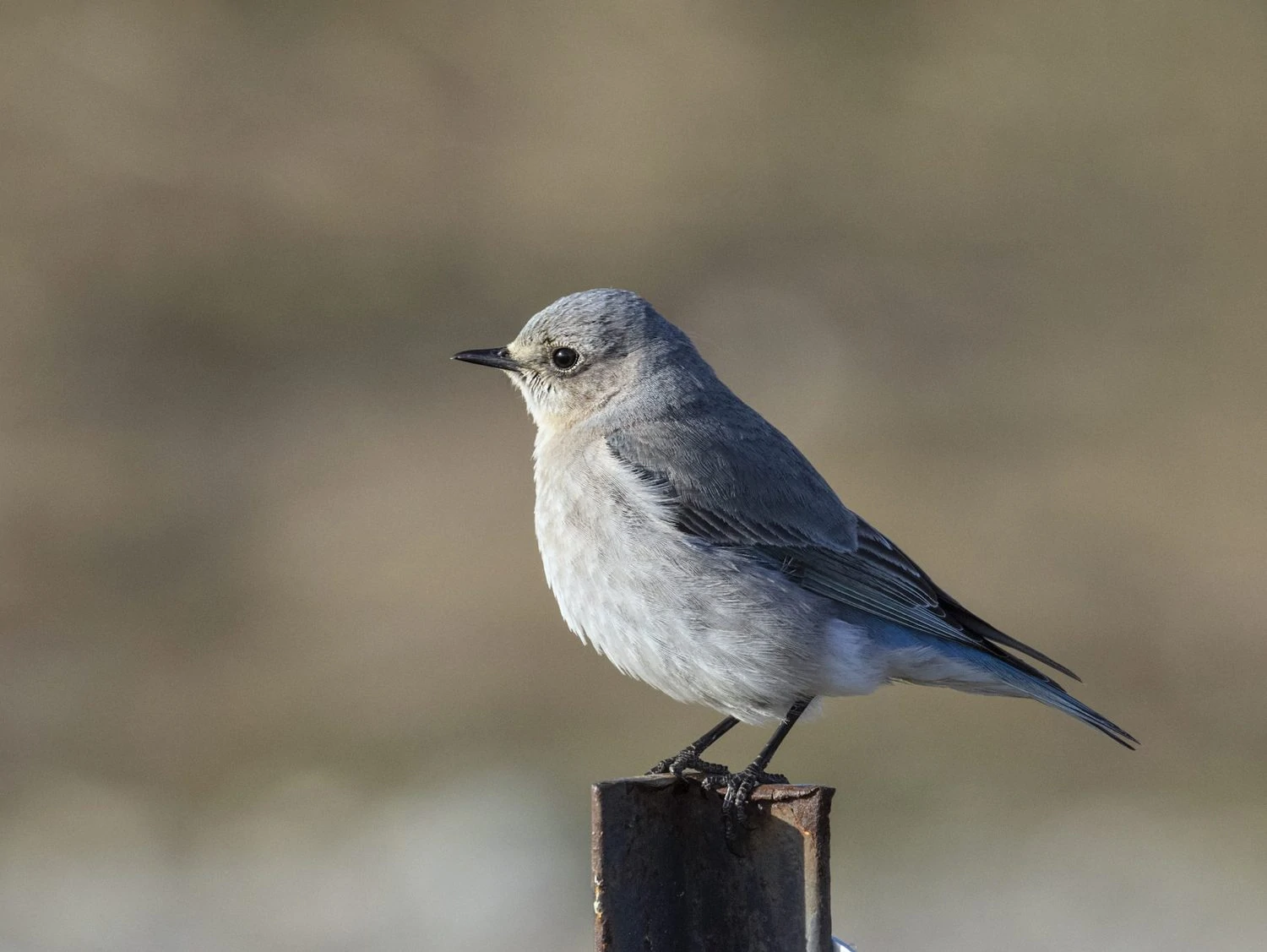
Mountain Bluebirds are the most blue of all the bluebirds; the males are a beautiful bright blue on the back and paler blue underneath and white under the tails. Females are gray-brown with some blue streaks in their tails and wings.
- Sialia currucoides
- Length: 6.3-7.9 in (16-20 cm)
- Weight: 1.1 oz (30 g)
- Wingspan: 11.0-14.2 in (28-36 cm)
Mountain Bluebirds breed at up to 12,000 feet above sea level in northwestern US states, Canada, and Alaska, before migrating to lower elevations in southwestern US states and Mexico for winter. Some birds may remain all year in the middle of their range, and they can be spotted in the Midwest during migration.
You can find mountain bluebirds in open areas with short grass, shrubs, and trees around prairies, tundra, grasslands and meadows. They can often be seen perched on fences or powerlines.
Insects make up most of the diet of Mountain Bluebirds, especially beetles, grasshoppers, and caterpillars. They also eat seeds and small fruits in winter, such as grapes, juniper, currants, elderberries, sumac, mistletoe, and hackberry.
Mountain Bluebirds song:
Attract Mountain Bluebirds to your yard by putting up nest boxes. They may also visit platform feeders for mealworms and sometimes suet or fruit. You can also try planting some of the fruiting plants they enjoy in winter.
4. Indigo Bunting
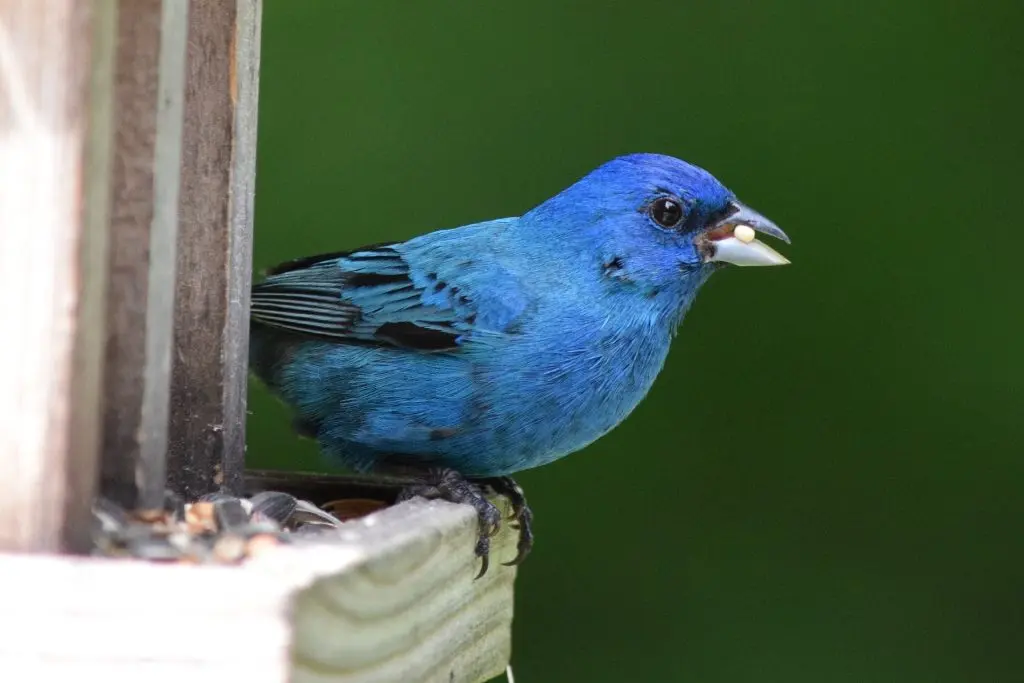
Indigo Buntings are small birds, with the males being bright blue with streaks of black on the wings and tail, and the females are brown.
- Passerina cyanea
- Length: 4.7-5.1 in (12-13 cm)
- Weight: 0.4-0.6 oz (12-18 g)
- Wingspan: 7.5-8.7 in (19-22 cm)
Indigo Buntings migrate far from breeding grounds in eastern US states, southeastern Canada, and southern US states to winter grounds in Florida, Central and South America, and the Caribbean.
You can find Indigo Buntings in weedy fields and shrubby areas foraging for seeds and insects.
Indigo Bunting Song:
Attract Indigo Buntings to your backyard with small seeds such as nyjer and thistle.
5. Lazuli Bunting
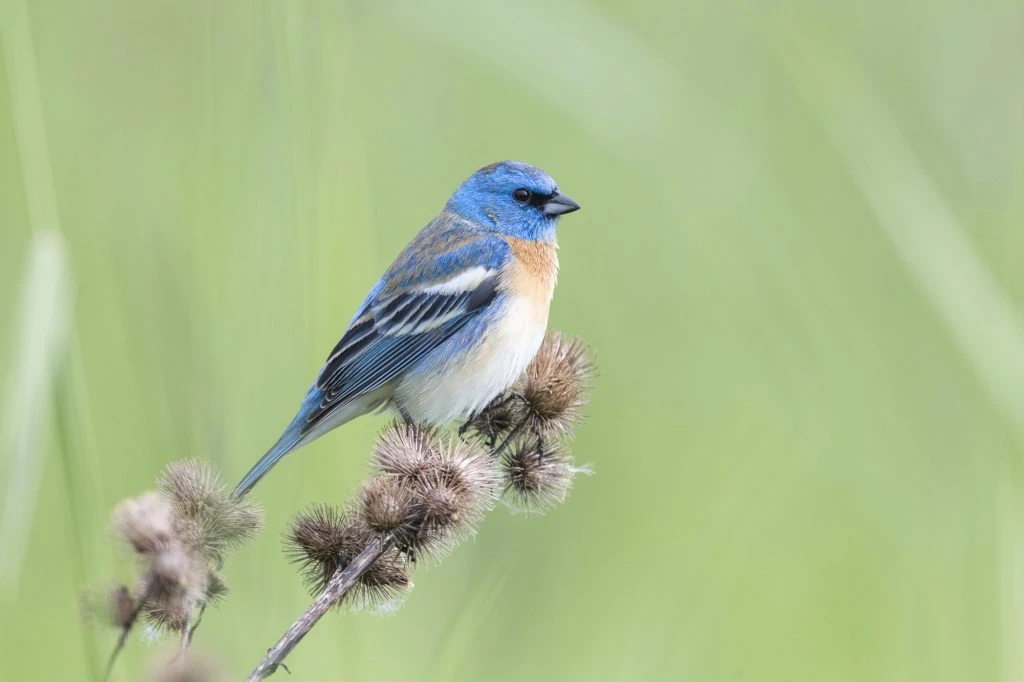
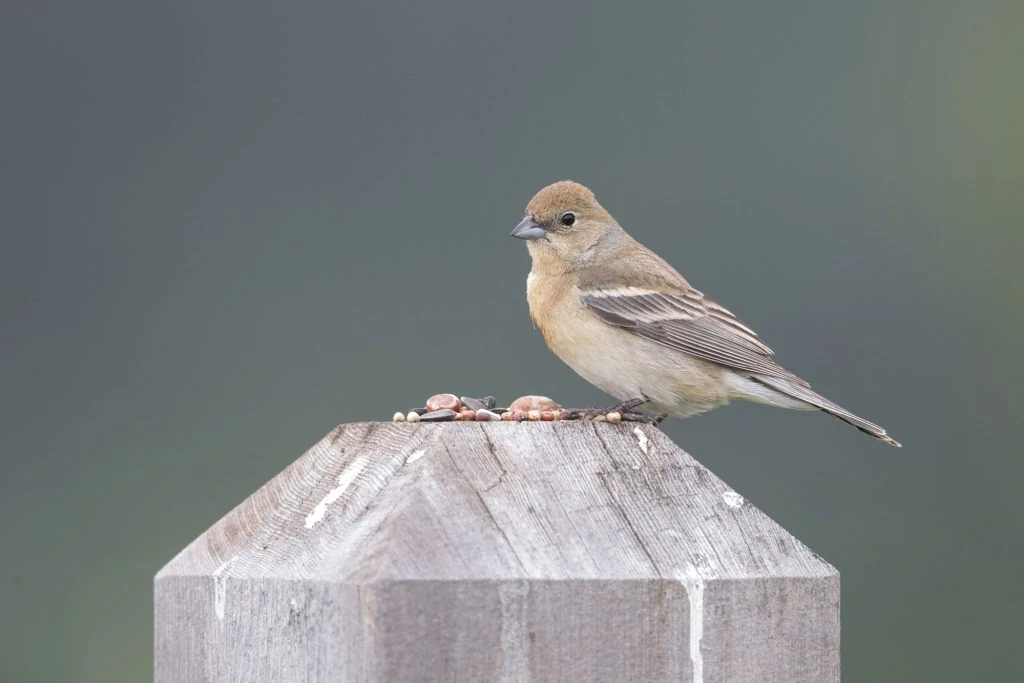
Named after the gemstone Lapis Lazuli, the male Lazuli Bunting shows a bright blue head and back, orange breast, white wingbars, and belly. The female is dull brown, with a more stocky build.
- Passerina amoena
- Length: 5.1-5.9 in (13-15 cm)
- Weight: 0.5-0.6 oz (13-18 g)
- Wingspan: 8.7 in (22 cm)
Lazuli Buntings breed in western US states before migrating to the Pacific coast of Mexico.
You can find Lazuli Buntings in and around open, brushy areas, streamside thickets, grassy grounds, and even towns.
The diet of a Lazuli Bunting is primarily insects in the summer and seeds in the winter. Most of the summer, it feeds on small animals like grasshoppers, caterpillars, ants, and more. During the winter, it has stocked up on seeds and waste grain.
Lazuli Bunting Song:
Nests of Lazuli Buntings are firmly attached in forked branches or vertical stems. They may be built within shrubs or vines or on low trees. The female builds it with grass, weeds, and leaves. There lay up to six eggs, and they hatch in about twelve days. Meanwhile, the young leave the nest within two weeks.
Fun fact: Lazuli buntings molt their feathers during migration. They shed before they reach their destination for the winter.
6. Blue Jay
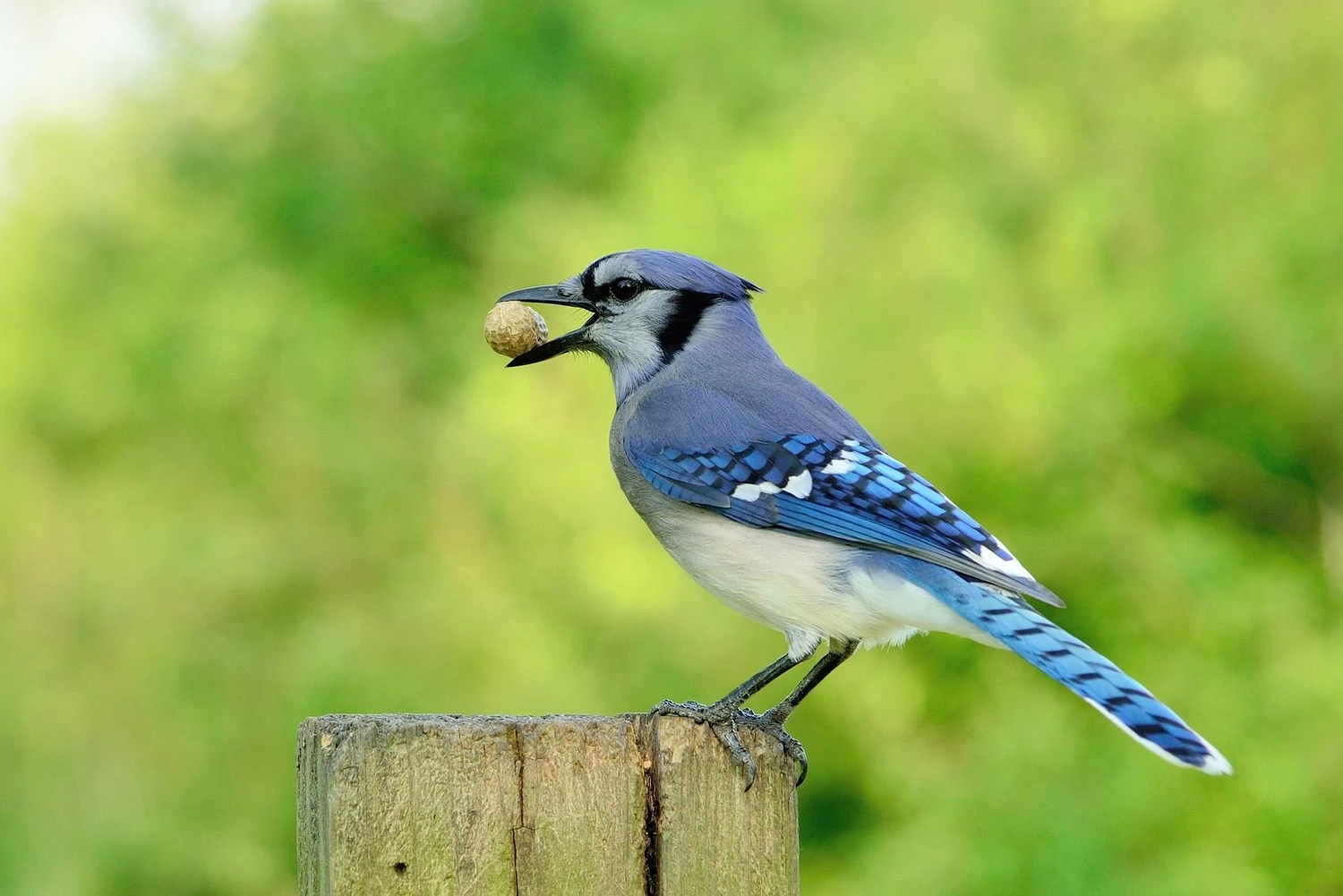
Blue Jays are common large songbirds with a blue upright crest, blue and black backs, and white undersides.
- Cyanocitta cristata
- Length: 9.8-11.8 in (25-30 cm)
- Weight: 2.5-3.5 oz (70-100 g)
- Wingspan: 13.4-16.9 in (34-43 cm)
Blue Jays live in eastern US states and Southern Canada all year. Some birds will migrate west for winter but not very frequently.
They are noisy birds that travel in family groups eating acorns when available. They can be found in forests, mainly near oak, as they eat acorns. They can also be found in backyards near feeders. As well as acorns, they eat insects, nuts and seeds, and grain. They may also take eggs from nests or take nestlings.
Blue Jay Call:
Blue Jays are large birds and prefer to fly in, grab a peanut or sunflower seed and take it away to feed. They prefer platform or tray feeders to make it easy to make a quick exit.
Attract Blue Jays to your backyard with peanuts, sunflower seeds, and suet. They prefer these on open tray feeders or hopper feeders on a post. They will also enjoy a birdbath.
7. California Scrub-Jay
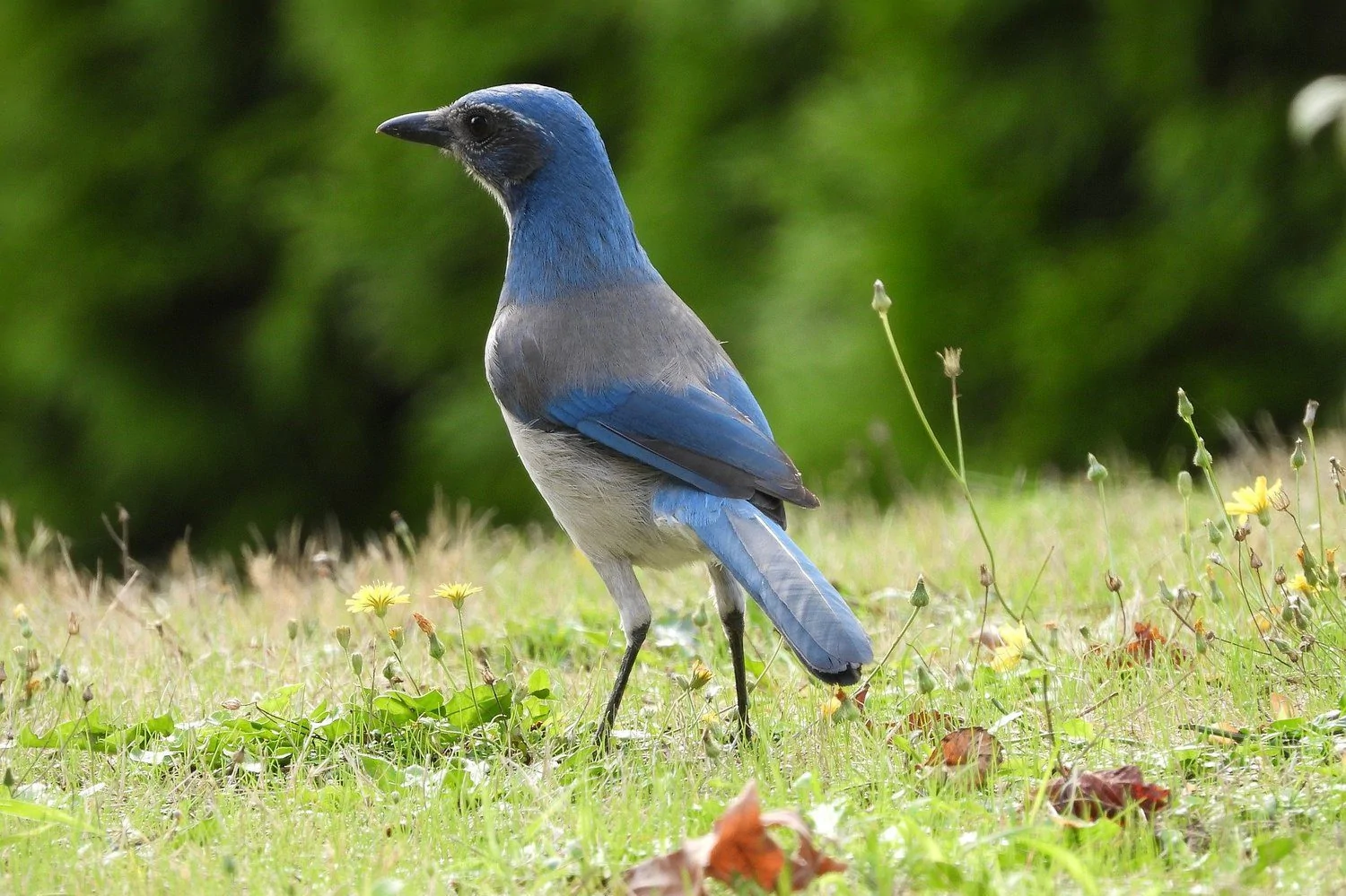
California Scrub-Jays are large songbirds with long tails, whitish undersides and rich blue and gray backs, and a bright blue breast band. They are larger than a robin but smaller than a crow. They look visually similar to the Woodhouse’s Scrub-Jay but with more vivid colors.
- Aphelocoma californica
- Length: 11.0-11.8 in (28-30 cm)
- Weight: 2.5-3.5 oz (70-100 g)
- Wingspan: 15.3 in (39 cm)
California Scrub-Jays are resident all year on the Pacific Coast from British Columbia down to Baja California.
You can find California Scrub-Jay in scrub, oak woodlands, and in suburban yards and parks. They eat insects and fruit during spring and summer and then seeds and nuts, especially acorns, in fall and winter.
California Scrub-Jay sounds: Their call is high-pitched and repetitive. They also sing a courtship song of soft whistles.
Nests of California Scrub-Jay are usually hidden in oak trees and can take up to 10 days to construct the nest made of twigs and a soft lining. They lay 1 – 5 eggs, and the eggs take around 17 – 19 days to hatch.
Attract California Scrub-Jays to your backyard with sunflower seeds and peanuts in your feeders.
Fun fact: California Scrub-Jay will screech over the body of a dead jay and invite others to do the same, and this can last up to half an hour, according to the University of California – Davis
8. Florida Scrub-Jay
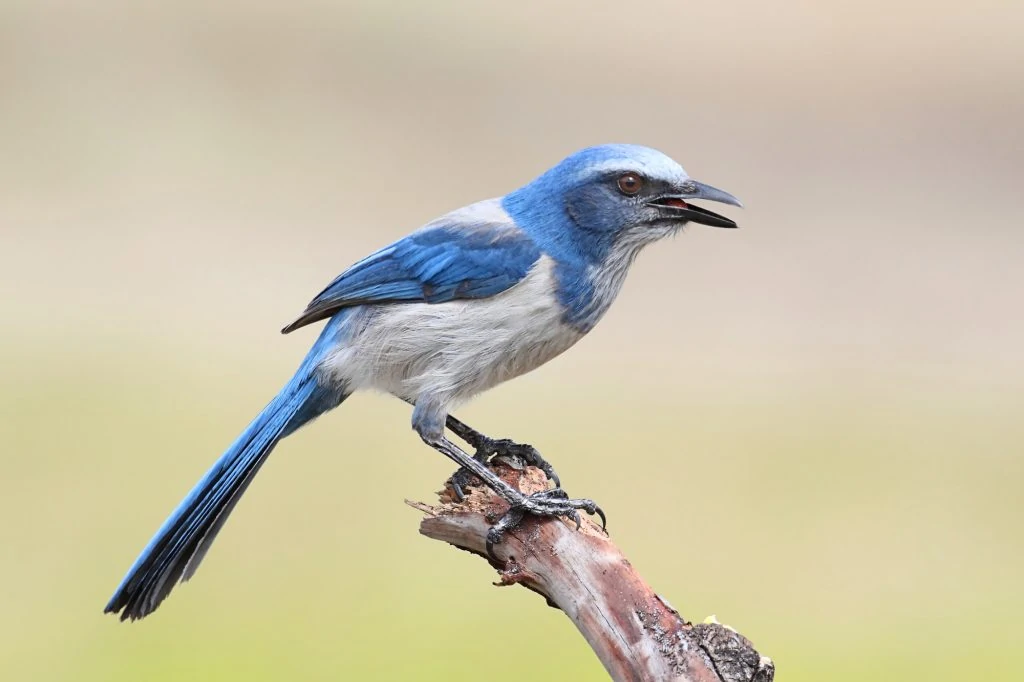
Florida Scrub-Jays are blue, with gray bellies, backs, and foreheads. They have long blue tails and do not have a crest on their heads. Males and females look the same, but juveniles are grayer and have gray heads.
- Aphelocoma coerulescens
- Length: 9.1-11.0 in (23-28 cm)
- Weight: 2.3-3.3 oz (66-92 g)
- Wingspan: 13.0-14.2 in (33-36 cm)
As the name would suggest, Florida Scrub-Jays are found in Florida, and they do not migrate. They are endemic to Florida, meaning they are only native here.
You can find Florida Scrub-Jays in relatively open scrubby areas that are sandy and contain oak scrub. They will be found on the ground looking for insects and berries, and they also eat acorns. They are, however, listed as vulnerable on the ICUN Red List.
Florida Scrub-Jay sounds: They make quite harsh calls and spend a lot of time calling to each other.
Nests of Florida Scrub-Jays are usually in oak trees or shrubs, and they form cooperative flocks, which include young from the previous year. These flocks help protect from predators and feed their young. The offspring then find a territory of their own.
Fun fact: Florida Scrub-Jays break acorns apart by holding them in their feet and using their bills to hammer on the acorn until it breaks open.
9. Island Scrub Jay
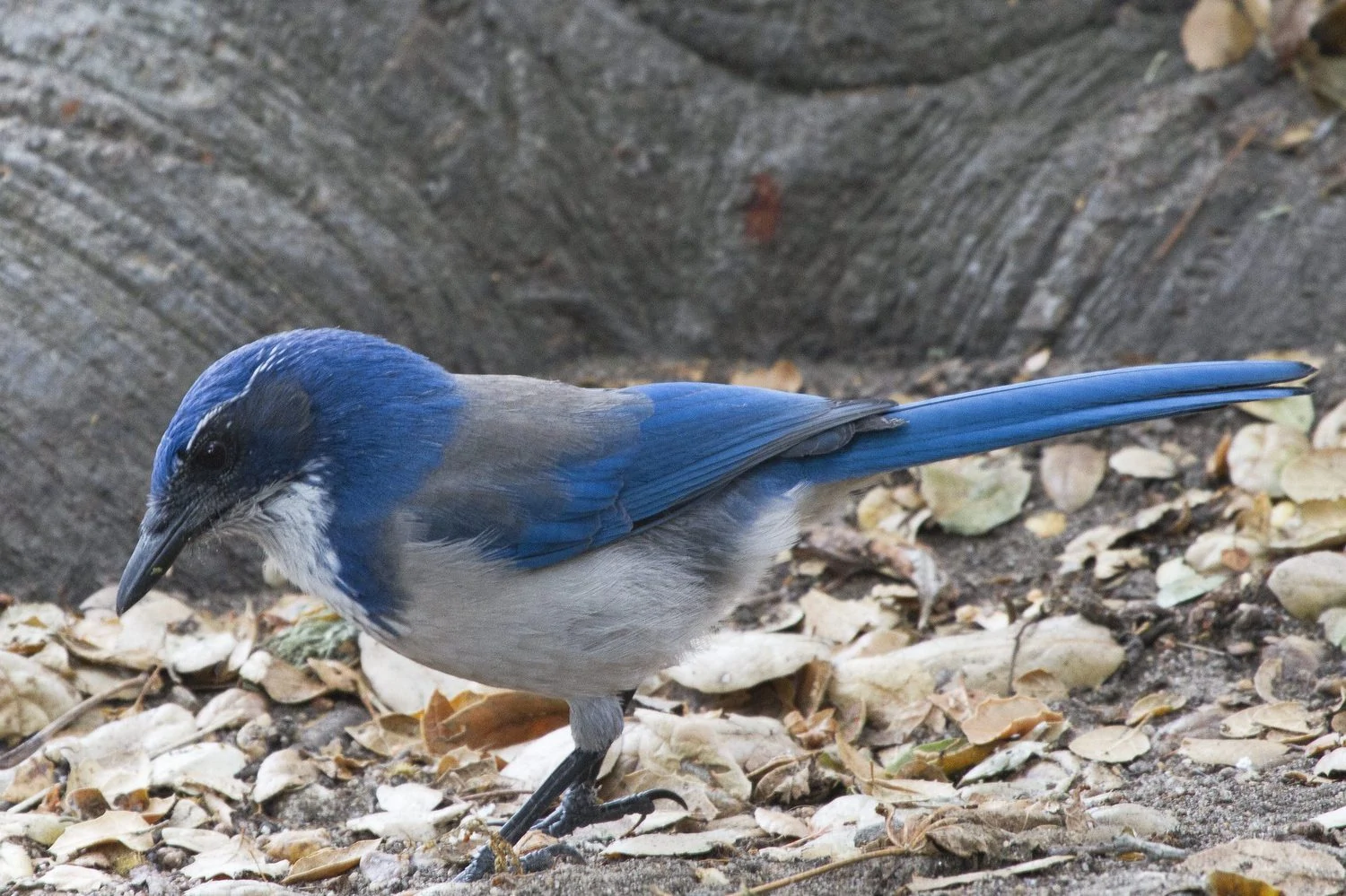
Island Scrub-Jays are large, brightly-colored birds similar to California Scrub-Jays except that their feathers are darker and more richly-colored. They are blue from their head to their tail on the back and gray on top of their wings. They have white throats.
- Aphelocoma insularis
- Length: 11 – 12 in (28 – 33 cm)
- Weight: 4.1 – 4.4 oz (116 – 125 g)
Island Scrub-Jays are permanent residents of Santa Cruz Island, hence their name, and they do not migrate. The island is dominated by oak woodland and chaparral with several streamside thickets and other trees.
The diet of Island Scrub-Jays is mostly insects, small lizards, mice, and even the eggs and young of other smaller birds. In the fall, it feasts on acorns, using its beak to break the shell.
Island Scrub-Jay sounds:
Nest of Island Scrub-Jays are hidden in oak trees. It is sturdy and built with twigs and lined with rootlets and animal hair to keep it soft on the inside. They lay around four eggs and they take about eighteen days to hatch. As to when the young leave the nest, there’s not a lot of data to go from.
Fun Fact: Since the Island Scrub-Jay never leaves Santa Cruz Island, it has the smallest range of any North American bird.
10. Mexican Scrub-Jay
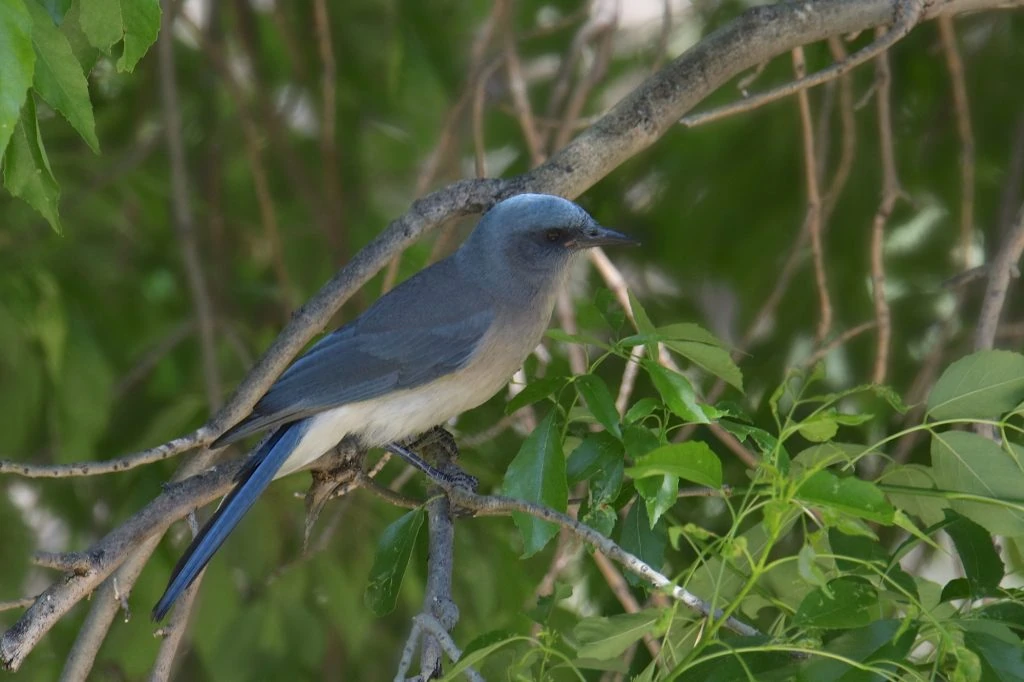
Mexican Jays are medium-sized, pale, bluish-gray birds. It is a lighter color compared to other jays and with a grayish upper neckline and chest. Its bill is small and black.
- Aphelocoma wollweberi
- Length: 11.4 in (29 cm)
- Weight: 4.2-4.8 oz (120-135 g)
You can find Mexican Jays in open oak and pine woods and forests.
Mexican Jays eat mostly insects, small reptiles, and other birds’ eggs and young. In the winter, they mainly eat acorns and pine nuts which they stored during the previous season.
Mexican Scrub-Jay sounds:
Nests of Mexican Jays are built by both males and females in trees and protected by thick leaves. The nests are built of sticks and twigs with a lining of rootlets and plants.
They lay around five eggs that take about eighteen days to hatch. The young leave the nest after about twenty-five days, but they may be cared for by the flock for several weeks.
Fun Fact: Northern Flickers usually follow Mexican Jays in flight during migration because they use the loud, shrill voices of the Mexican Jay to warn themselves of any predators.
11. Pinyon Jay
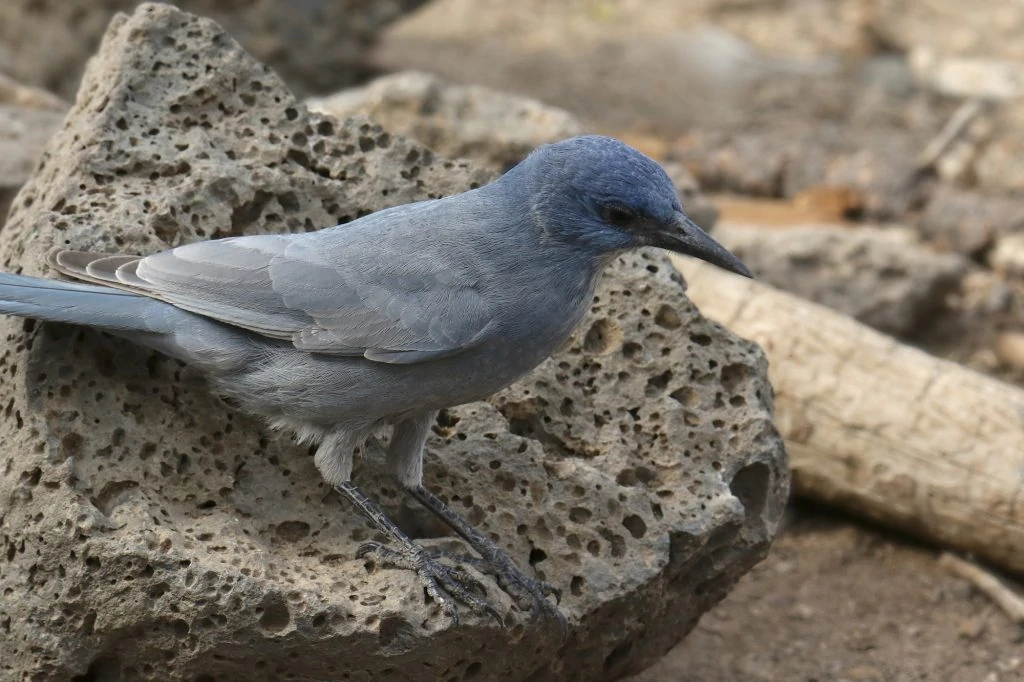
Pinyon Jays are blue all over, with darker backs and paler bellies. They also have white throats, shorter tails, and do not have crests like other Jays, like Stellar’s Jays. Males and females look the same, but juveniles can look more grayish-blue.
- Gymnorhinus cyanocephalus
- Length: 10.2-11.4 in (26-29 cm)
- Weight: 3.2-4.2 oz (90-120 g)
- Wingspan: 18.1 in (46 cm)
Pinyon Jays are resident inland in western US states in pinyon-pine forests.
As well as seeds from pinyon-pine, Pinyon Jays will eat juniper berries, acorns, and other animals such as lizards, baby birds, and insects. They are opportunity feeders who will take most things and forage in large, noisy groups.
Pinyon Jay sounds: They make 3 ‘kaw’ like calls close together that rise and then fall and sometimes shake or tremble.
Nests of Pinyon Jays are built of sticks and grass in pine trees and lined with feathers and animal hair.
Fun fact: Pinyon Jays do not have feathers over their nostrils to prevent the sticky pine pitch from making them dirty.
12. Steller’s Jay
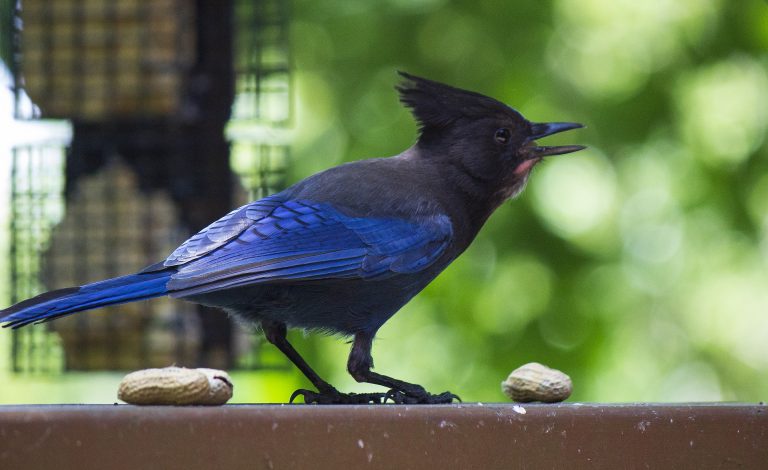
Steller’s Jays are large songbirds with black triangular crests that stick up from their heads. The rest of their heads and onto their chests and back are black, with the rest of their bodies being blue.
- Cyanocitta stelleri
- Length: 11.8-13.4 in (30-34 cm)
- Weight: 3.5-4.9 oz (100-140 g)
- Wingspan: 17.3 in (44 cm)
Steller’s Jays are resident in western US states, western Canada, Mexico, and Central America.
You can find Steller’s Jays in evergreen forests in the mountains, and they will also be found around picnic tables, campgrounds, and backyard feeders.
Steller’s Jays eat most things they can forage for, including insects, seeds, nuts, berries, eggs, and nestlings, but also making a nuisance of themselves around garbage and your unguarded picnic!
Steller’s Jay sounds: They make ‘kaw’ sounds as well as fast two-toned calls, peeps, and harsh guttural sounds. Steller’s Jays can also mimic other noises such as other bird species and even sprinklers and alarms.
Nests of Stellar’s Jays are usually near the top of conifer trees and are built from leaves and plant material held together with mud and lined with soft pine needles.
Attract Steller’s Jays to your backyard with peanuts and suet.
Fun fact: Stellar’s Jays make nests out of the mud.
13. Black-throated Blue Warbler
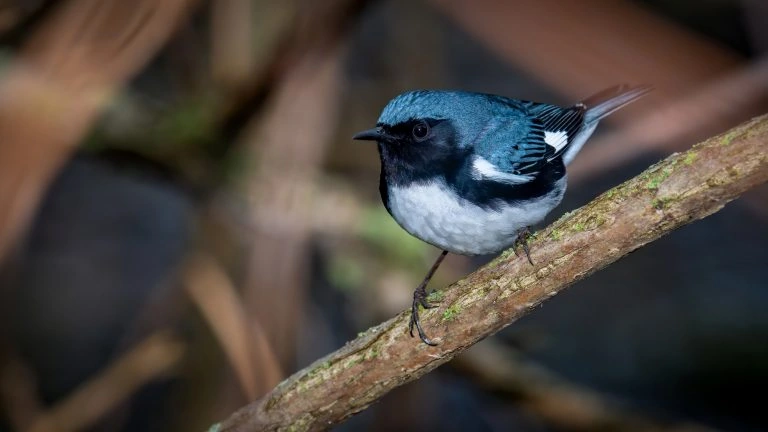
Male Black-throated Blue Warblers are a lovely rich blue color on the back and white underneath. They are unusual amongst the predominantly yellow warblers. Females are very plain in comparison and are grayish-olive.
- Setophaga caerulescens
- Length: 4.3-5.1 in (11-13 cm)
- Weight: 0.3-0.4 oz (8-12 g)
- Wingspan: 7.5-7.9 in (19-20 cm)
Black-throated Blue Warblers breed in northeastern US states and Canada. They can also be seen during migration over eastern US states before wintering in Central America and the Caribbean.
You can find Black-throated Blue Warblers in lower areas of deciduous forests, shrubby areas, and sometimes backyards looking for spiders, flies, and caterpillars.
Black-throated Blue Warblers song:
Nests of Black-throated Blue Warblers are hidden in dense shrubs and made from bark held together with spiders’ webs and saliva. The nest is lined with animal hair and pine needles. They lay up to five eggs which take about two weeks to hatch and ten days for the young to leave the nest.
Fun Fact: Black-throated Blue Warblers listen out for males singing after the breeding season as this shows areas where males were successful as unsuccessful males do not sing.
14. Cerulean Warbler
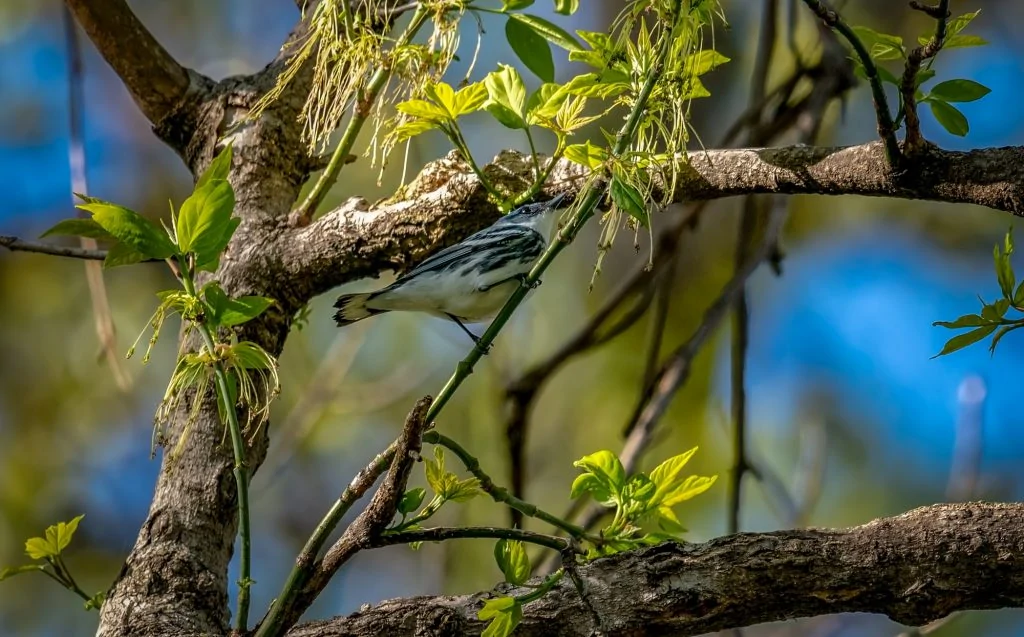
Male Cerulean Warblers are small songbirds that have rich blue heads with a black band around their neck. Their backs and sides are blue with black streaks. Their throats, breasts, and bellies are white. On their wings are two white bars.
Females are bluish-green and have yellow eyebrows and a yellowish tinge underneath. They also have no streaks on their backs. Juveniles are more olive than blue with the same eyebrows as females. They also have prominent streaks on their sides but with the same white double wing bars.
- Setophaga cerulea
- Length: 4.5 – 5 inches (11 – 13 cm)
- Weight: 0.3 oz. (9 g)
- Wingspan: 7.5 inches (19 cm)
Cerulean Warblers breed in the Midwest and across to the east coast but can be seen during migration in southeastern states on their way to winter grounds in South America.
You can find Cerulean Warblers in mature forests with deciduous trees with large leaves. When migrating, they head for forested mountains.
Cerulean Warblers mostly forage in trees. They may catch insects in flight or search for insects, like caterpillars, among leaves and branches.
Cerulean Warblers’ song:
Nests of Cerulean Warblers are cup-shaped and naturally located in the higher, horizontal branches of trees. They are often made out of bark strips, spider silk, and grass made soft with moss and fur. The female lays three to five eggs that she has to incubate for about thirteen days.
Fun Fact: Females, when they exit their nests, tumble to the ground like a falling leaf but immediately release their wings and fly near the ground.
15. Common Grackle
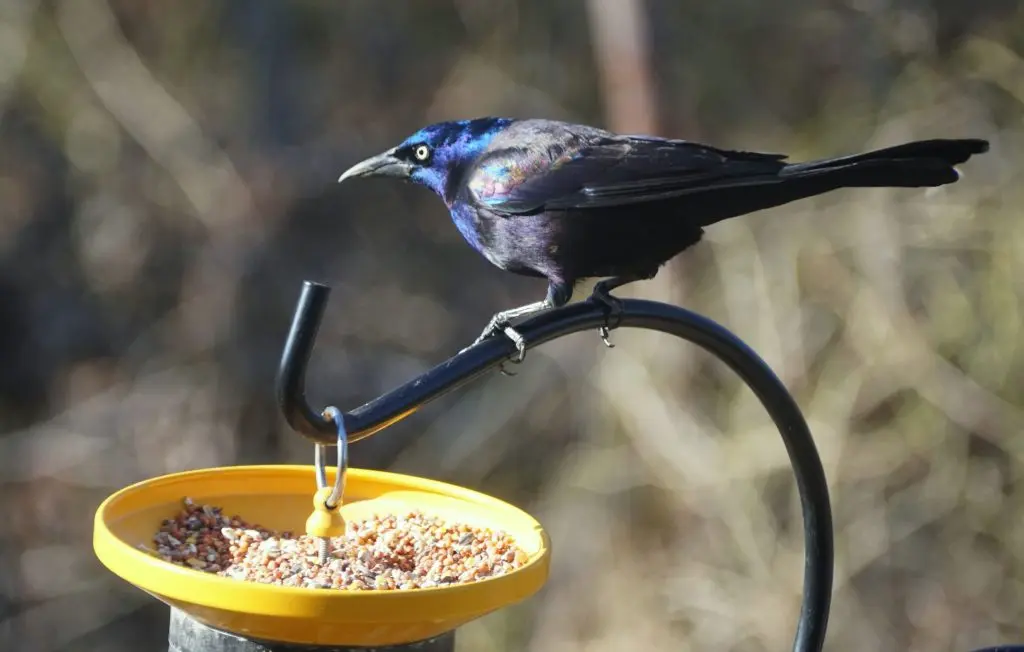
The Common Grackle is a blackbird taller and longer tailed than a typical blackbird with glossy iridescent bodies.
- Quiscalus quiscula
- Length: 11.0-13.4 in (28-34 cm)
- Weight: 2.6-5.0 oz (74-142 g)
- Wingspan: 14.2-18.1 in (36-46 cm)
Common Grackles are resident all year in southeastern states, but those that breed in Canada and the Midwest migrate south.
They eat many crops but mostly corn, and they gather in noisy groups high up in trees. Unfortunately, they will also eat garbage and so can be a nuisance. Their habitat is varied and includes open woodlands, marshes, parks, and fields.
They may gather in their millions in winter to forage and roost, mixed in with other species of blackbirds.
Common Grackle Call:
Attract more Common Grackles to your backyard with mixed grain and seed sprinkled on the ground or platform feeders.
16. Barn Swallow
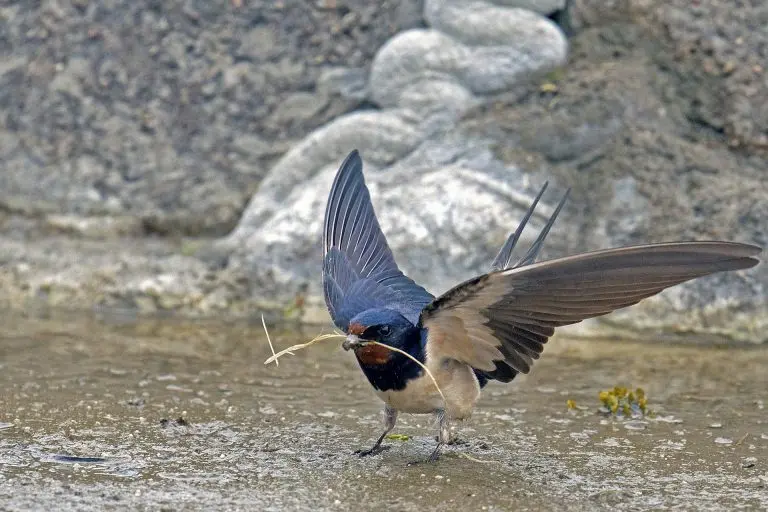
Barn Swallows are small birds with a deep-blue back, wings and tail, and reddish-brown underneath and across the face. Their tail has long outer feathers that give a deep fork. The dark color of their back can make them look black-and-white.
- Hirundo rustica
- Length: 5.9-7.5 in (15-19 cm)
- Weight: 0.6-0.7 oz (17-20 g)
- Wingspan: 11.4-12.6 in (29-32 cm)
Barn Swallows breed in Canada and the US before heading to Central and South America. They can be found flying over meadows, farms, and fields looking for insects and usually build mud nests on man-made structures such as in barns.
Barn Swallow call:
Attract Barn Swallows by putting up nest boxes or cups, and they may eat ground-up eggshells on a platform feeder.
17. Blue-gray Gnatcatcher
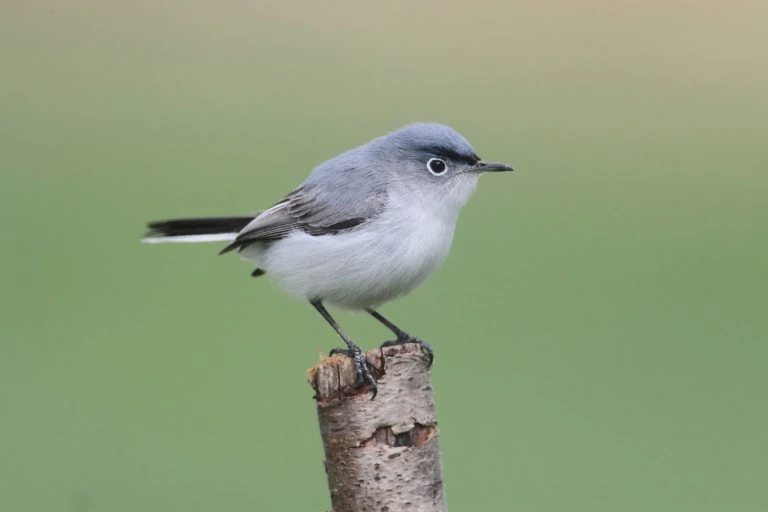
A tiny songbird in a soft blue-gray color on the back and grayish-white underneath. They have a black tail and patches on their wings. Males have a distinctive black ‘V’ shape on their foreheads in summer.
They have long tails and legs and small, thin, straight bills.
- Length: 3.9-4.3 in (10-11 cm)
- Weight: 0.2-0.3 oz (4.8-8.9 g)
- Wingspan: 6.3 in (16 cm)
Blue-gray Gnatcatchers breed in deciduous forests in the Southern and Eastern States before heading south. They do also remain all year in Florida and in southern coastal areas.
Nests of Blue-gray Gnatcatchers look similar to hummingbird nests as they are small and built onto branches so they look like a tree knot covered in lichen.
Feeding on insects and spiders by constantly hopping around and scaring them by flicking their tail up and down.
18. Blue Grosbeak
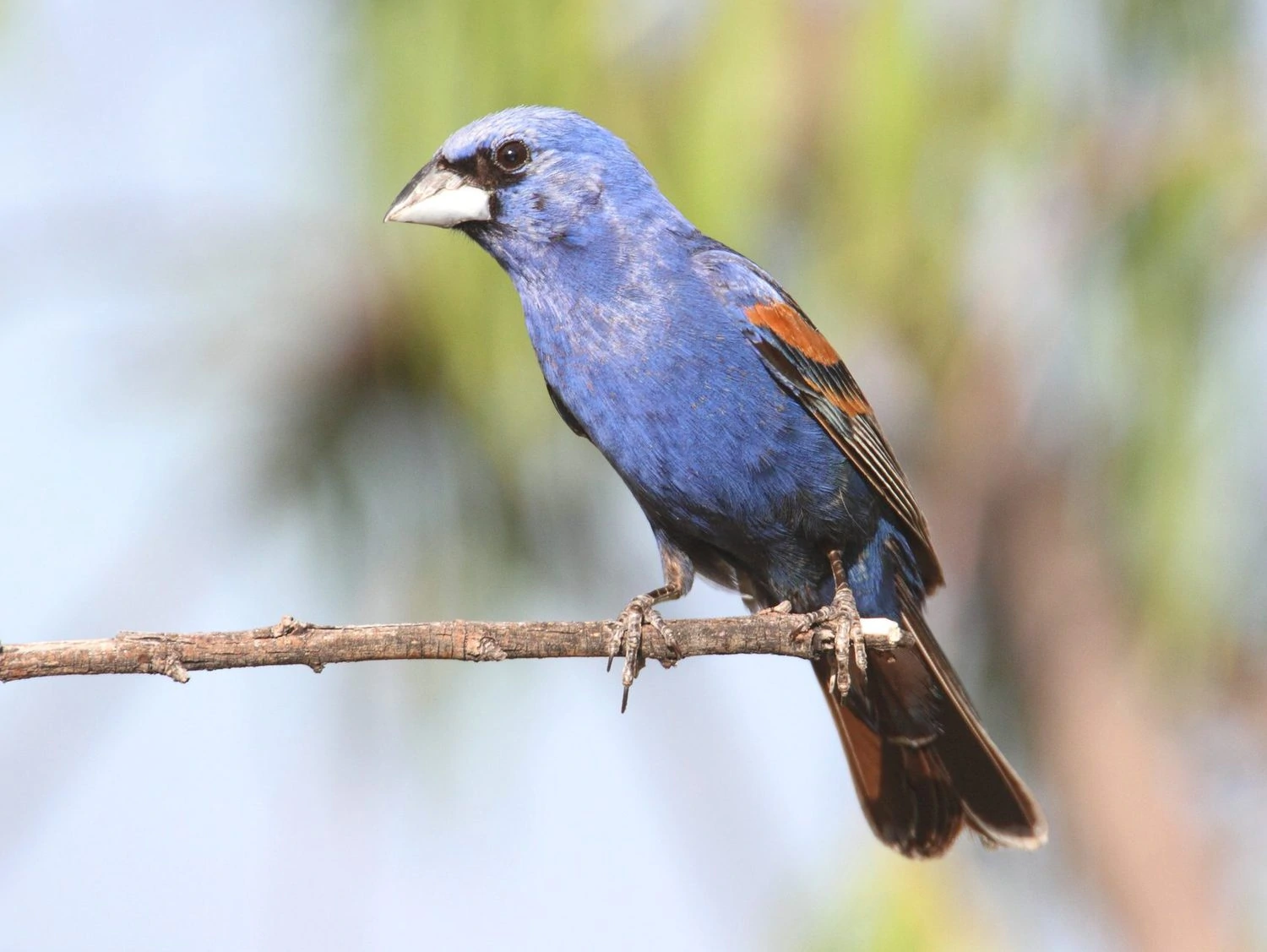
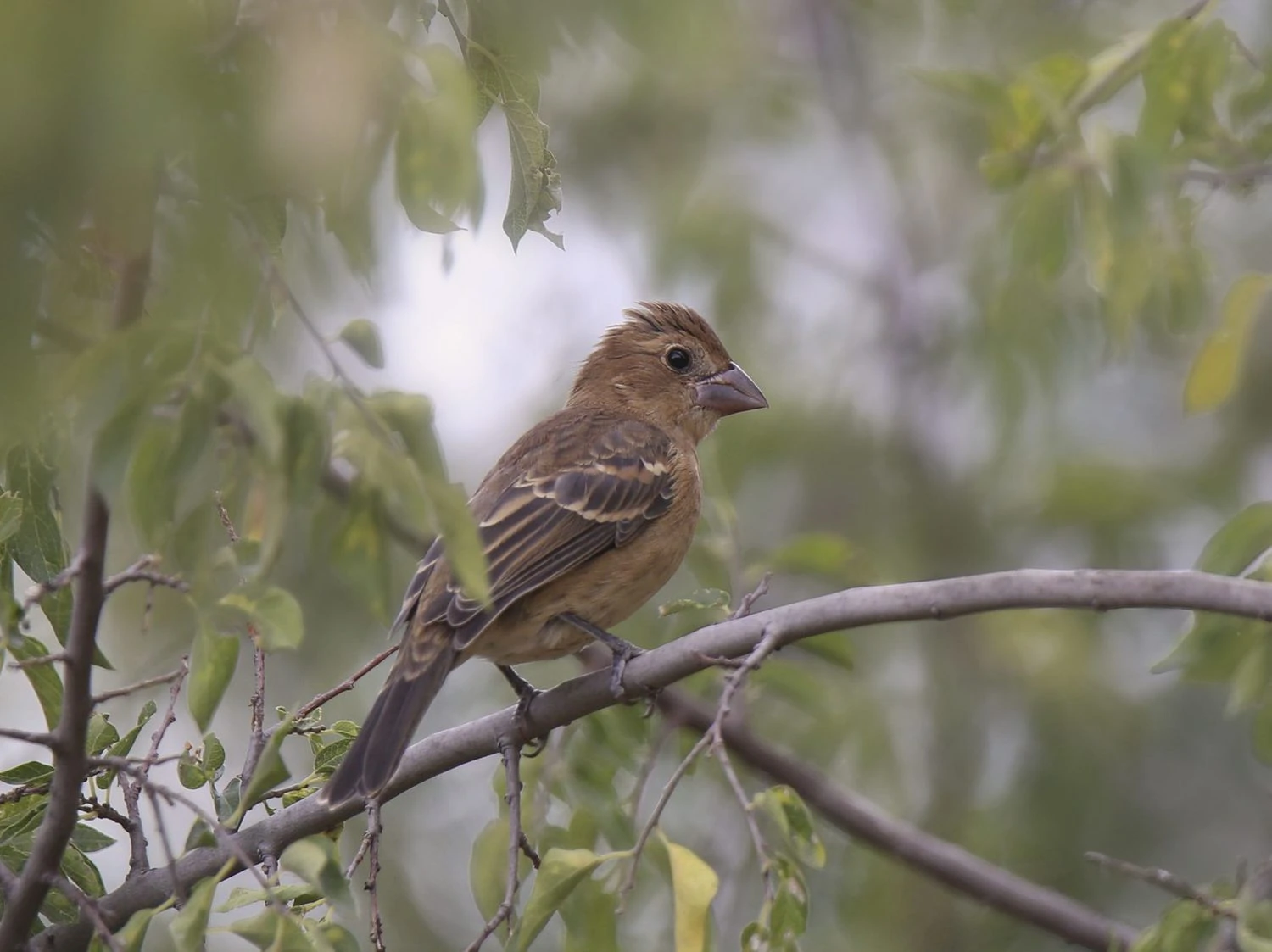
Blue Grosbeaks are medium-sized birds with a large bills. Males are blue with two brown wing bars. Females are mostly brown but with some blue coloring on their bodies. They share the same brown wing bars as the male. Juvenile males are covered in patchy blue-cinnamon feathers with brown wing bars.
- Passerina caerulea
- Length: 5.9-6.3 in (15-16 cm)
- Weight: 0.9-1.1 oz (26-31 g)
- Wingspan: 11.0 in (28 cm)
Blue Grosbeaks breed in southern US states and the Great Plains before migrating to Mexico, Central America, and the Caribbean.
You can find the Blue Grosbeak in shrubby habitats. It prefers semi-open areas with cultivated lands, overgrown fields, woodland edges, or hedgerows.
A regular diet of insects and seeds sustains the Blue Grosbeak. During the summer, they feast on caterpillars, praying mantises, grasshoppers, and beetles, as well as spiders and snails. They also eat seeds, weeds, and grass too.
Blue Grosbeak Song:
Nests of Blue Grosbeaks can be found low in the ground, around shrubs and vines. They usually are found up to ten feet above the ground and built from twigs, weeds, leaves, and bark. The inside is lined with snakeskin, paper, fine grass, and animal hair. They lay up to five eggs that take about ten days to hatch. In another ten days, the young leave the nest.
Fun fact: The Blue Grosbeak got its name from the French “gros bec,” which literally means “Big Beak”.
19. Woodhouse’s Scrub-Jay
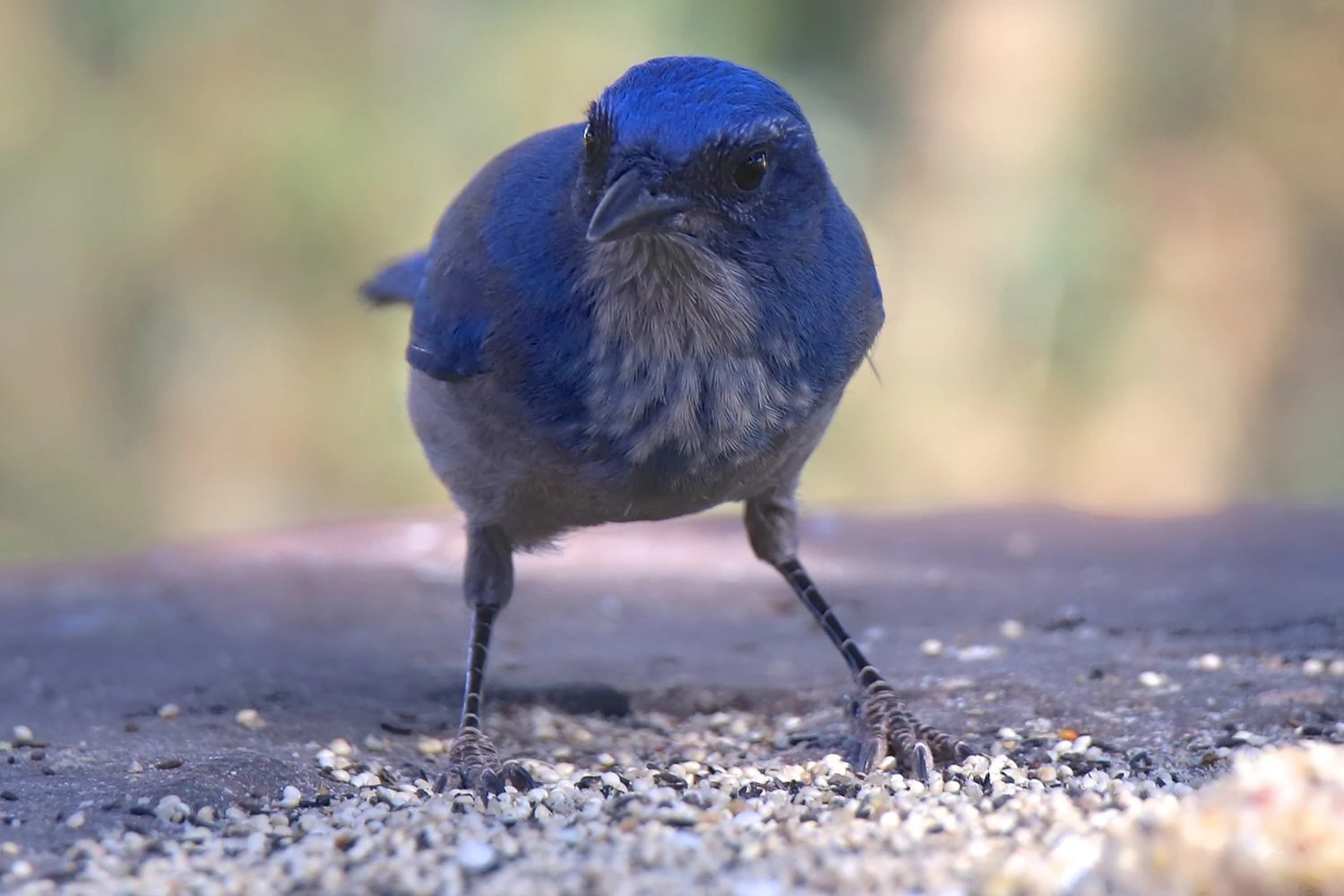
Woodhouse’s Scrub-Jays are the Blue-Jays of the Southwest with lovely blue and gray coloring. They are light blue and dark gray on the back and light gray underneath. Their tails are long and blue.
They are duller in color than California Scrub-Jays and have only a small necklace, and lack the crests of Blue Jays and Stellar’s Jays.
- Aphelocoma woodhouseii
- Length: 11.0-11.8 in (28-30 cm)
- Weight: 2.5-3.5 oz (70-100 g)
Woodhouse’s Scrub-Jays are resident inland in southwest US states and Mexico. You can find them in wooded areas with pinyon-juniper and scrubby areas.
Insects and fruit make up most of the diet of Woodhouse’s Scrub-Jays in summer and nuts and seeds in winter.
Woodhouse’s Scrub-Jay sounds:
Nests of Woodhouse’s Scrub-Jay are fairly simple platforms made of twigs and lined with moss and grass.
Attract Woodhouse’s Scrub-Jays to your backyard with sunflower seeds and peanuts.
Fun Fact: Woodhouse’s Scrub-Jays are thieves that steal food from other birds stores, especially Acorn Woodpeckers’ granary tree store of acorns.
20. Tree Swallow
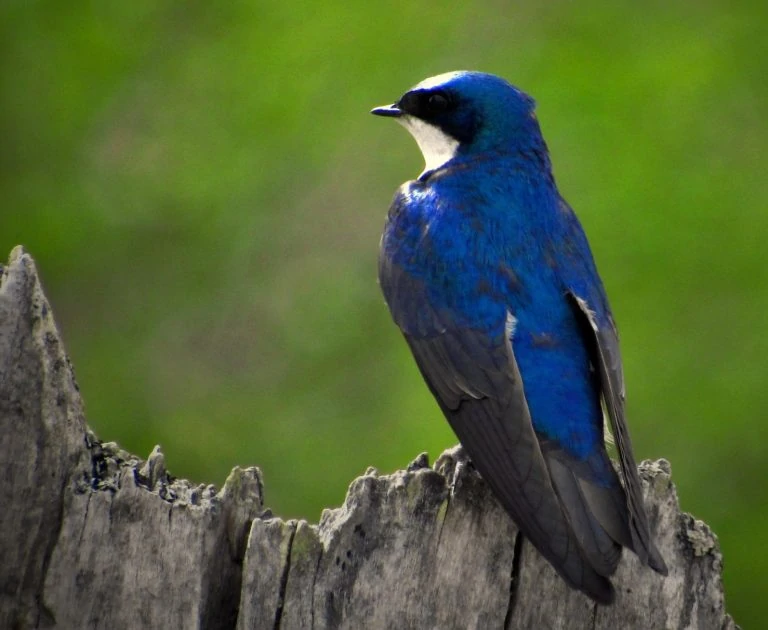
Tree Swallows are small birds that are blue-green on the back and white below, with darker gray wings in the males. Females are browner in color.
- Length: 4.7-5.9 in (12-15 cm)
- Weight: 0.6-0.9 oz (16-25 g)
- Wingspan: 11.8-13.8 in (30-35 cm)
Tree Swallows spend their summer breeding over much of the US, Canada, and Alaska before migrating to the Gulf Coast, Florida, and Mexico and along the southern border.
They can be seen during migration over southern states and can form huge flocks in the hundreds of thousands.
Tree Swallows can be found in wooded swamps, fields, marshes, and near water that provide the flying insects that they feed on.
To attract more Tree Swallows to your backyard try nest boxes as they readily take to them.
21. Great Blue Heron
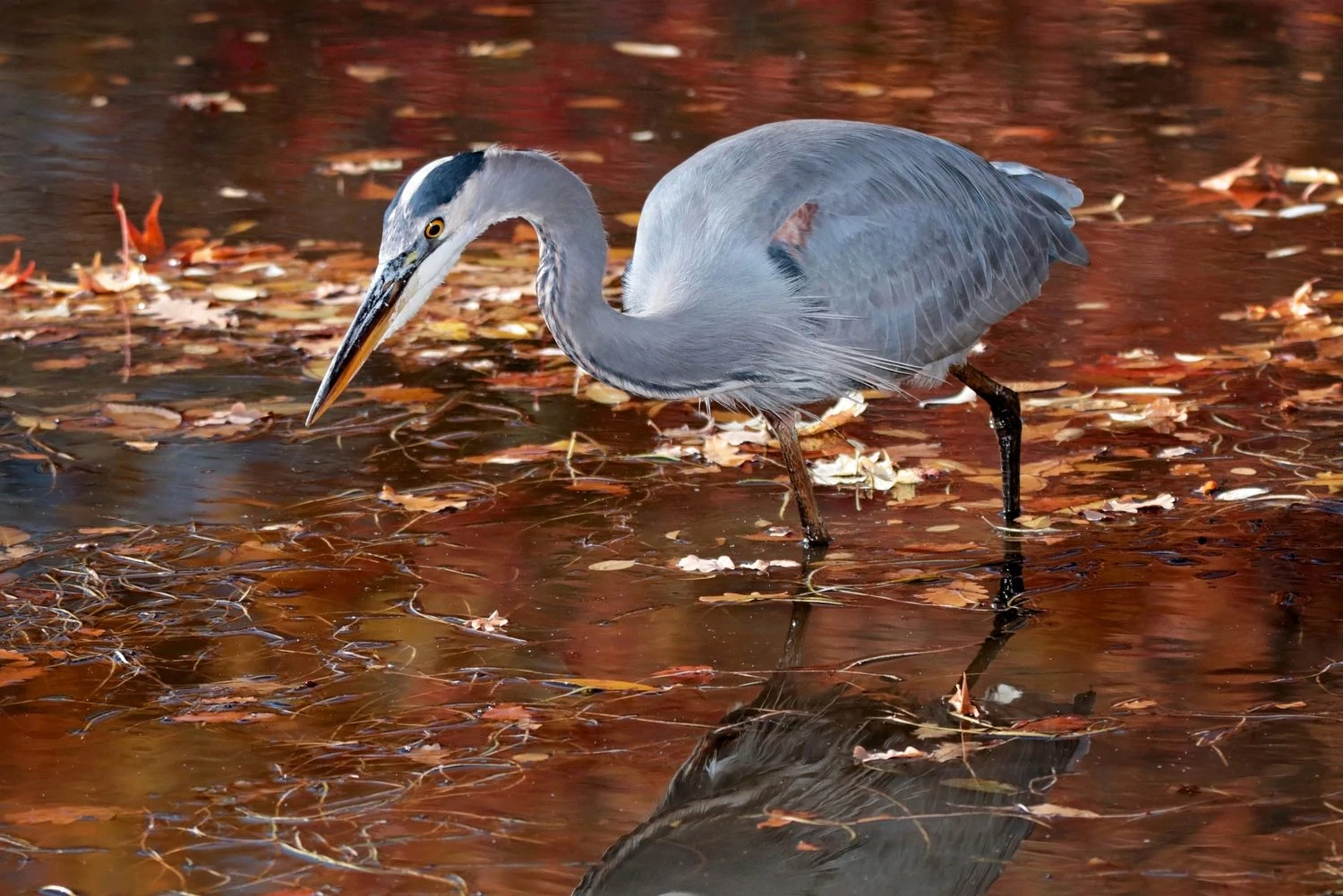
Great Blue Herons are very large, majestic birds that are the largest heron native to North America.
They have a white face with a black crest or plume that extends from the front of their eyes to the back of their heads. Their bills are yellow-orangish.
They have long gray necks with black and white streaking in the front, grayish-blue bodies, and long gray legs.
- Ardea herodias
- Length: 46 – 52 in (117 – 132 cm)
- Weight: 128 oz (3628 g)
- Wingspan: 77 – 82 in (196 – 208 cm)
Great Blue Herons remain in most US states all year, but those that breed in the Mid-West and Canada migrate south.
The Great Blue Heron has a white morph subspecies called the Great White Heron in Florida.
You can find Great Blue Herons in many wetland environments. They can be present in fresh and saltwater marshes, mangrove swamps, flooded marshes, lake edges, or shorelines.
Great Blue Herons’ main diet consists of fish, frogs, salamanders, shrimps, crabs, dragonflies, grasshoppers, and other aquatic insects.
They capture their prey when wading or standing in water. They may also hover over water, dive into the water, jump feet-first from perches, or float on the water’s surface.
Great Blue Heron Call:
Nests of Great Blue Herons are found in colonies, high up in trees close to water. The nests are made with twigs and sticks lined with softer material.
Since Great Blue Herons reuse their nests, they may repair and add more to the nests over time, growing them in size.
The female then lays two to seven eggs. Both parents take turns incubating the eggs for around four weeks.
Fun Fact: Great Blue Herons defend their feeding territory with dramatic wing outstretched displays, with their heads thrown back.
21. Purple Martin
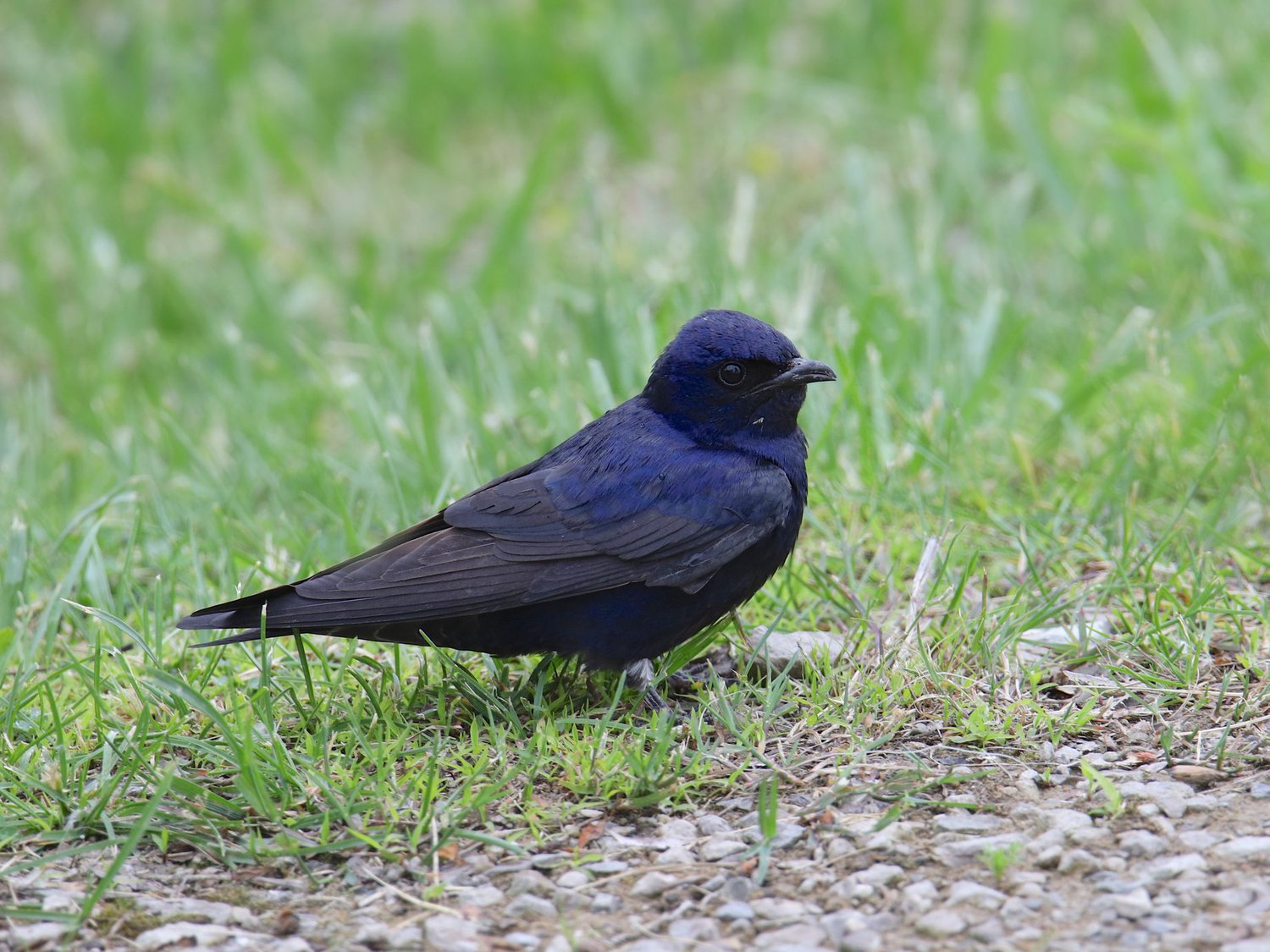
- Progne subis
- Length: 7.5-7.9 in (19-20 cm)
- Weight: 1.6-2.1 oz (45-60 g)
- Wingspan: 15.3-16.1 in (39-41 cm)
Purple Martins breed predominantly in eastern United States and Canada, but they are also found along the West Coast. They migrate to Soith America in winter in vast flocks.

